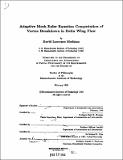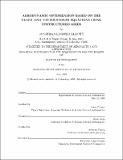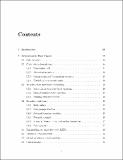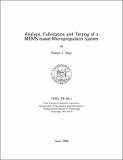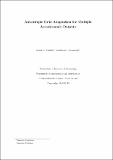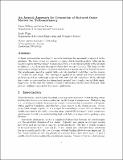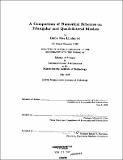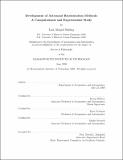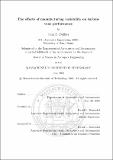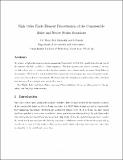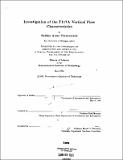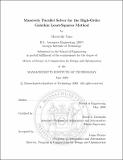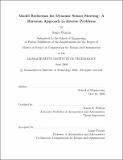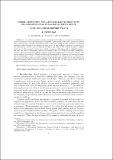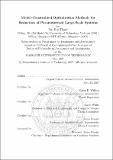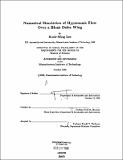Browsing Aerospace Computational Design Laboratory: Technical Reports by Title
Now showing items 1-20 of 33
-
Adaptive Mesh Euler Equation Computations of Vortex Breakdown in Delta Wing Flow
(Aerospace Computational Design Lab, Dept. of Aeronautics & Astronautics, Massachusetts Institute of Technology, 1993-01)A solution method for the three-dimensional Euler equations is formulated and implemented. The solver uses an unstructured mesh of tetrahedral cells and performs adaptive refinement by mesh-point embedding to increase ... -
Aerodynamic Optimization Based on the Euler and Navier-Stokes Equations using Unstructured Grids
(Aerospace Computational Design Laboratory, Dept. of Aeronautics & Astronautics, Massachusetts Institute of Technology, 1998-06)The overall problem area addressed is that of efficient aerodynamic shape design through the use of computational fluid dynamics (CFD). A method is presented for performing optimization including modal inverse design and ... -
Analysis and design of axisymmetric transonic flow with linearized three-dimensional flow prediction
(Aerospace Computational Design Laboratory, Dept. of Aeronautics & Astronautics, Massachusetts Institute of Technology, 1997-02)The primary goal of this thesis is the application of the proven stream-surface based Newton method to analysis/design of an axisymmetric nacelle with the actuator disk modeling of a fan. And to further utilize the benefits ... -
Analysis of Dual Consistency for Discontinuous Galerkin Discretizations of Source Terms
(Aerospace Computational Design Laboratory, Dept. of Aeronautics & Astronautics, Massachusetts Institute of Technology, 2006-09)The effects of dual consistency on discontinuous Galerkin (DG) discretizations of solution and solution gradient dependent source terms are examined. Two common discretizations are analyzed: the standard weighting technique ... -
Analysis, Fabrication and Testing of a MEMS-based Micropropulsion System
(Aerospace Computational Design Laboratory, Dept. of Aeronautics & Astronautics, Massachusetts Institute of Technology, 1999-06)Various trends in the spacecraft industry are driving the development of low-thrust propulsion systems. These may be needed for fine attitude control, or to reduce the mass of the propulsion system through the use of small ... -
Anisotropic Grid Adaptation for Multiple Aerodynamic Outputs
(Aerospace Computational Design Laboratory, Dept. of Aeronautics & Astronautics, Massachusetts Institute of Technology, 2007-08)Anisotropic grid–adaptive strategies are presented for viscous flow simulations in which the accurate prediction of multiple aerodynamic outputs (such as the lift, drag, and moment coefficients) is required from a single ... -
An Arnoldi Approach for Generation of Reduced Order Models for Turbomachinery
(Aerospace Computational Design Laboratory, Dept. of Aeronautics & Astronautics, Massachusetts Institute of Technology, 1999)A linear reduced-order aerodynamic model is developed for aeroelastic analysis of turbo-machines. The basis vectors are constructed using a block Arnoldi method. Although the model is cast in the time domain in state-space ... -
A Comparison of Numerical Schemes on Triangular and Quadrilateral Models
(Aerospace Computational Design Lab, Dept. of Aeronautics & Astronautics, Massachusetts Institute of Technology, 1988-05) -
Computing Bounds for Linear Functionals of Exact Weak Solutions to Poisson’s Equation
(Aerospace Computational Design Laboratory, Dept. of Aeronautics & Astronautics, Massachusetts Institute of Technology, 2003)We present a method for Poisson’s equation that computes guaranteed upper and lower bounds for the values of linear functional outputs of the exact weak solution of the infinite dimensional continuum problem using traditional ... -
Development of Astronaut Reorientation Methods: A Computational and Experimental Study
(Aerospace Computational Design Laboratory, Dept. of Aeronautics & Astronautics, Massachusetts Institute of Technology, 2008-06)Past spaceflight missions have shown that astronauts adapt their motor-control strategies to the microgravity environment. Even though astronauts undergo hundreds of training hours, the strategies for locomotion and ... -
The effects of manufacturing variability on turbine vane performance
(Aerospace Computational Design Laboratory, Dept. of Aeronautics & Astronautics, Massachusetts Institute of Technology, 2008-06)Gas turbine vanes have airfoil shapes optimized to deliver specific flow conditions to turbine rotors. The limitations of the manufacturing process with regards to accuracy and precision mean that no vane will exactly match ... -
High Order Finite Element Discretization of the Compressible Euler and Navier-Stokes Equations
(Aerospace Computational Design Laboratory, Dept. of Aeronautics & Astronautics, Massachusetts Institute of Technology, 2001-04)We present a high order accurate streamline-upwind/Petrov-Galerkin (SUPG) algorithm for the solution of the compressible Euler and Navier-Stokes equations. The flow equations are written in terms of entropy variables which ... -
Integral methods for three-dimensional boundary layers
(Aerospace Computational Design Laboratory, Dept. of Aeronautics & Astronautics, Massachusetts Institute of Technology, 1998-02)Several distinct issues important in integral approximations of the three-dimensional boundary-layer equations are addressed. One of these is the requirement, justified on the basis of the nature of the full differential ... -
Investigation of the F117A Vortical Flow Characteristics Preliminary Results
(Aerospace Computational Design Lab, Dept. of Aeronautics & Astronautics, Massachusetts Institute of Technology, 1992-10)The investigation of the vortical flow around the F117A Stealth Fighter is presented in order to demonstrate the capability to resolve leading edge vortices with an adaptive finite element solver for the Euler equations. ... -
Massively Parallel Solver for the High-Order Galerkin Least-Squares Method
(Aerospace Computational Design Laboratory, Dept. of Aeronautics & Astronautics, Massachusetts Institute of Technology, 2009-06)A high-order Galerkin Least-Squares (GLS) finite element discretization is combined with massively parallel implicit solvers. The stabilization parameter of the GLS discretization is modified to improve the resolution ... -
Measurement of the Mass Flow and Tangential Momentum Accommodation Coefficient in Silicon Micromachined Channels
(Aerospace Computational Design Laboratory, Dept. of Aeronautics & Astronautics, Massachusetts Institute of Technology, 1997-01)An analytic and experimental investigation into gaseous flow with slight rarefaction through long microchannels is undertaken in an attempt to obtain values of the Tangential Momentum Accommodation Coefficient (TMAC) ... -
Model Reduction for Dynamic Sensor Steering: A Bayesian Approach to Inverse Problems
(Aerospace Computational Design Laboratory, Dept. of Aeronautics & Astronautics, Massachusetts Institute of Technology, 2008-06)In many settings, distributed sensors provide dynamic measurements over a specified time horizon that can be used to reconstruct information such as parameters, states or initial conditions. This estimation task can be ... -
Model Reduction for Large-Scale Systems with High Dimensional Parametric Input Space
(Aerospace Computational Design Laboratory, Dept. of Aeronautics & Astronautics, Massachusetts Institute of Technology, 2007-08)A model-constrained adaptive sampling methodology is proposed for reduction of large-scale systems with high-dimensional parametric input spaces. Our model reduction method uses a reduced basis approach, which requires the ... -
Model-Constrained Optimization Methods for Reduction of Parameterized Large-Scale Systems
(Aerospace Computational Design Laboratory, Dept. of Aeronautics & Astronautics, Massachusetts Institute of Technology, 2007-05)Most model reduction techniques employ a projection framework that utilizes a reduced-space basis. The basis is usually formed as the span of a set of solutions of the large-scale system, which are computed for selected ... -
Numerical Simulation of Hypersonic Flow Over a Blunt Leading Edge Delta Wing
(Aerospace Computational Design Lab, Dept. of Aeronautics & Astronautics, Massachusetts Institute of Technology, 1989-10)Euler and Navier-Stokes results are presented for a blunt delta wing at Mach 7.15 and 300 angle of attack. The viscous calculations were done at a Reynolds number based on chord of 5.85 x 106 with freestream and wall ...

